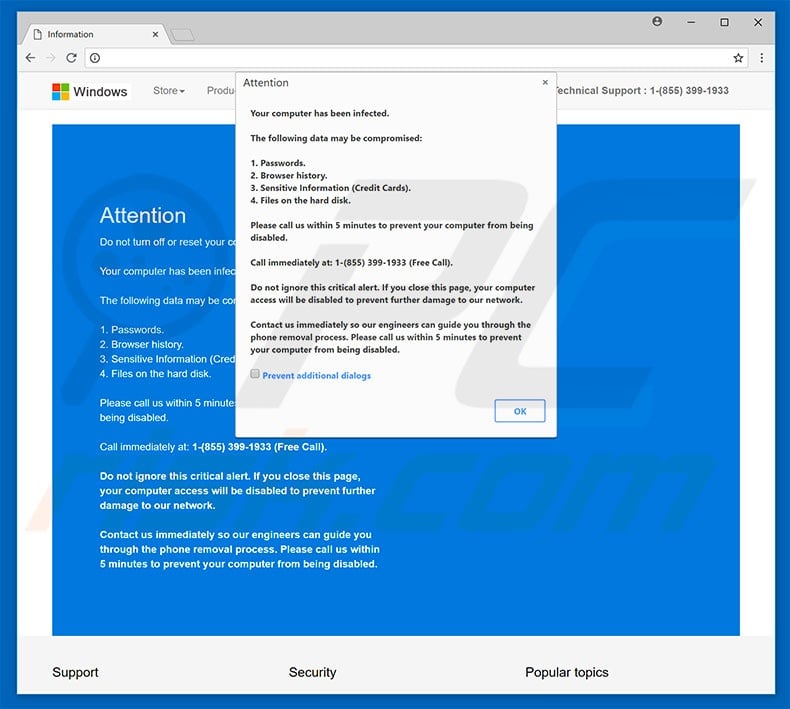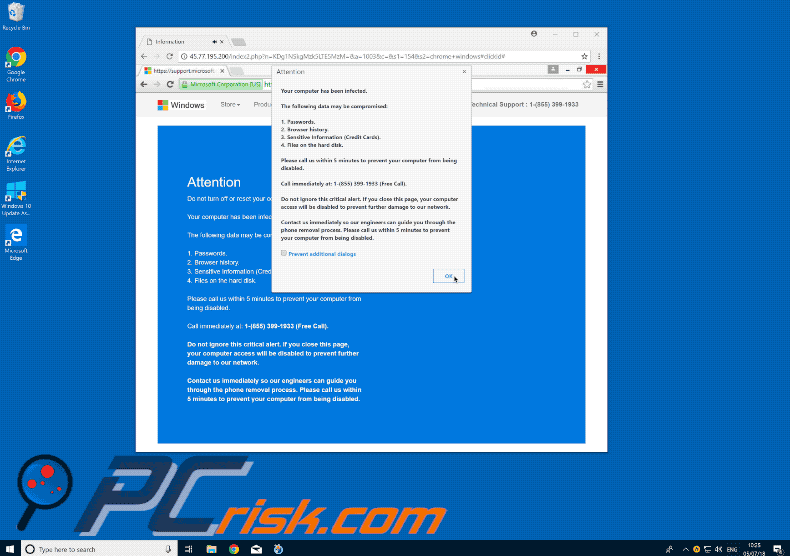Attention Your Computer Has Been Infected POP-UP Scam
Phishing/ScamAlso Known As: "Attention Your computer has been infected" virus
Get free scan and check if your device is infected.
Remove it nowTo use full-featured product, you have to purchase a license for Combo Cleaner. Seven days free trial available. Combo Cleaner is owned and operated by RCS LT, the parent company of PCRisk.com.
What is Attention Your Computer Has Been Infected?
Similar to Your Computer Might Be Infected By Trojans, Computer Detected To Be Corrupted, Spyware Detected On Your Computer!, and many others, "Attention Your Computer Has Been Infected" is a fake error message displayed by deceptive websites.
In most cases, users visit these sites inadvertently - they are redirected by intrusive advertisements (delivered by other rogue sites) or potentially unwanted programs (PUPs) that infiltrate systems without permission. As well as causing redirects, potentially unwanted programs deliver intrusive advertisements and record user-system information.

The error message essentially states that system is infected and personal data (banking information, logins/passwords, history, files, etc.) is at risk. The malware must be eliminated immediately and users are encouraged to call fake 'tech support' via a telephone number ["1-(855) 399-1933"] provided. Users are then supposedly guided through the malware removal process.
This is a scam - the "Attention Your Computer Has Been Infected" error is fake. Cyber criminals attempt to scare and trick unsuspecting users into calling and paying for tech support that is not required - your computer is probably optimized and virus-free. Ignore "Attention Your Computer Has Been Infected" and never attempt to call the aforementioned telephone number.
This error can be removed simply by closing the web browser. Some rogue sites employ scripts that prevent users from closing browsing tabs/windows. In these cases, terminate the browser via Task Manager or restart the system. Do not restore the previous session, otherwise the next time you open the browser, you will return to the malicious site/s.
Potentially unwanted programs deliver various intrusive advertisements, such as coupons, banners, pop-ups, and so on. These are delivered using various tools (e.g., "virtual layers") that enable placement of third party graphical content on any site. Therefore, intrusive ads often conceal underlying content, significantly diminishing the web browsing experience.
These ads can redirect to infectious websites or execute scripts that stealthily download/install malware. Therefore, even a single click might result in high-risk computer infections. Potentially unwanted programs are also notorious for data tracking. Research shows that many PUPs record information that includes personal details.
IP addresses, website URLs visited, pages viewed, search queries, and other collected data is later shared with third parties (potentially, cyber criminals). These people misuse private information to generate revenue. Therefore, the presence of data-tracking apps can lead to serious privacy issues or even identity theft. You are advised to uninstall all PUPs immediately.
| Name | "Attention Your computer has been infected" virus |
| Threat Type | Phishing, Scam, Social Engineering, Fraud |
| Symptoms | Unauthorized online purchases, changed online account passwords, identity theft, illegal access of one's computer. |
| Distribution methods | Deceptive emails, rogue online pop-up ads, search engine poisoning techniques, misspelled domains. |
| Damage | Loss of sensitive private information, monetary loss, identity theft. |
| Malware Removal (Windows) |
To eliminate possible malware infections, scan your computer with legitimate antivirus software. Our security researchers recommend using Combo Cleaner. Download Combo CleanerTo use full-featured product, you have to purchase a license for Combo Cleaner. 7 days free trial available. Combo Cleaner is owned and operated by RCS LT, the parent company of PCRisk.com. |
As mentioned above, "Attention Your Computer Has Been Infected" shares many similarities with dozens of other fake errors. All claim that system is damaged , however, these claims are merely attempts to extort money from gullible users. PUPs are also known to share many similarities.
By offering "useful features", they attempt to give the impression of legitimacy. Bear in mind, however, that these programs are designed only to generate revenue for the developers.
Rather than giving any real value for regular users, they cause unwanted redirects, gather sensitive information, and deliver intrusive ads, thereby posing a direct threat to your privacy and Internet browsing safety.
How did potentially unwanted programs install on my computer?
Some PUPs are known to have official download/installation websites, however, due to the lack of knowledge and careless behavior of many users, these programs typically infiltrate systems without consent. Be aware that developers promote PUPs using intrusive advertising and "bundling" methods.
"Bundling" is essentially stealth installation of PUPs together with regular software. Developers hide "bundled" PUPs within various sections (usually "Custom/Advanced" settings) of the download/installation processes.
Furthermore, many users are likely to click advertisements and skip download/installation steps. In doing so, they expose their systems to risk of various infections and compromise their privacy.
How to avoid installation of potentially unwanted applications?
To prevent this situation, be very cautious when browsing the Internet and downloading/installing software. Developers invest many resources into intrusive ad design, thereby making them seem legitimate. When clicked, however, most lead to dubious websites (gambling, adult dating, pornography, and similar).
If you continually encounter these ads, check the list of installed apps/browser plug-ins and remove any suspicious entries. In addition, carefully analyze each window of the download/installation dialogs and opt-out of all additionally-included programs. Programs must be downloaded from official sources only, using direct download links.
Third party downloaders/installers often include rogue apps (developers monetize them via "bundling" method). Therefore, do not use these tools. The key to computer safety is caution. If your computer is already infected with PUPs, we recommend running a scan with Combo Cleaner Antivirus for Windows to automatically eliminate them.
Text presented in "Attention Your Computer Has Been Infected" pop-up:
Attention
Your computer has been infected.
The following data may be compromised:
1. Passwords.
2. Browser history.
3. Sensitive information (Credit Cards).
4. Files on the hard disk.
Please call us within 5 minutes to prevent your computer from being disabled.
Call immediately at: 1-(855) 399-1933 (Free Call).
Do not ignore this critical alert. If you close this page, your computer access will be disabled to prevent further damage to our network.
Contact us immediately so our engineers can guide you through the phone removal process. Please call us within 5 minutes to prevent your computer from being disabled.
The appearance of "Attention Your Computer Has Been Infected" pop-up (GIF):

Instant automatic malware removal:
Manual threat removal might be a lengthy and complicated process that requires advanced IT skills. Combo Cleaner is a professional automatic malware removal tool that is recommended to get rid of malware. Download it by clicking the button below:
DOWNLOAD Combo CleanerBy downloading any software listed on this website you agree to our Privacy Policy and Terms of Use. To use full-featured product, you have to purchase a license for Combo Cleaner. 7 days free trial available. Combo Cleaner is owned and operated by RCS LT, the parent company of PCRisk.com.
Quick menu:
- What is "Attention Your computer has been infected" virus?
- How to identify a pop-up scam?
- How do pop-up scams work?
- How to remove fake pop-ups?
- How to prevent fake pop-ups?
- What to do if you fell for a pop-up scam?
How to identify a pop-up scam?
Pop-up windows with various fake messages are a common type of lures cybercriminals use. They collect sensitive personal data, trick Internet users into calling fake tech support numbers, subscribe to useless online services, invest in shady cryptocurrency schemes, etc.
While in the majority of cases these pop-ups don't infect users' devices with malware, they can cause direct monetary loss or could result in identity theft.
Cybercriminals strive to create their rogue pop-up windows to look trustworthy, however, scams typically have the following characteristics:
- Spelling mistakes and non-professional images - Closely inspect the information displayed in a pop-up. Spelling mistakes and unprofessional images could be a sign of a scam.
- Sense of urgency - Countdown timer with a couple of minutes on it, asking you to enter your personal information or subscribe to some online service.
- Statements that you won something - If you haven't participated in a lottery, online competition, etc., and you see a pop-up window stating that you won.
- Computer or mobile device scan - A pop-up window that scans your device and informs of detected issues - is undoubtedly a scam; webpages cannot perform such actions.
- Exclusivity - Pop-up windows stating that only you are given secret access to a financial scheme that can quickly make you rich.
Example of a pop-up scam:

How do pop-up scams work?
Cybercriminals and deceptive marketers usually use various advertising networks, search engine poisoning techniques, and shady websites to generate traffic to their pop-ups. Users land on their online lures after clicking on fake download buttons, using a torrent website, or simply clicking on an Internet search engine result.
Based on users' location and device information, they are presented with a scam pop-up. Lures presented in such pop-ups range from get-rich-quick schemes to fake virus scans.
How to remove fake pop-ups?
In most cases, pop-up scams do not infect users' devices with malware. If you encountered a scam pop-up, simply closing it should be enough. In some cases scam, pop-ups may be hard to close; in such cases - close your Internet browser and restart it.
In extremely rare cases, you might need to reset your Internet browser. For this, use our instructions explaining how to reset Internet browser settings.
How to prevent fake pop-ups?
To prevent seeing pop-up scams, you should visit only reputable websites. Torrent, Crack, free online movie streaming, YouTube video download, and other websites of similar reputation commonly redirect Internet users to pop-up scams.
To minimize the risk of encountering pop-up scams, you should keep your Internet browsers up-to-date and use reputable anti-malware application. For this purpose, we recommend Combo Cleaner Antivirus for Windows.
What to do if you fell for a pop-up scam?
This depends on the type of scam that you fell for. Most commonly, pop-up scams try to trick users into sending money, giving away personal information, or giving access to one's device.
- If you sent money to scammers: You should contact your financial institution and explain that you were scammed. If informed promptly, there's a chance to get your money back.
- If you gave away your personal information: You should change your passwords and enable two-factor authentication in all online services that you use. Visit Federal Trade Commission to report identity theft and get personalized recovery steps.
- If you let scammers connect to your device: You should scan your computer with reputable anti-malware (we recommend Combo Cleaner Antivirus for Windows) - cyber criminals could have planted trojans, keyloggers, and other malware, don't use your computer until removing possible threats.
- Help other Internet users: report Internet scams to Federal Trade Commission.
Share:

Tomas Meskauskas
Expert security researcher, professional malware analyst
I am passionate about computer security and technology. I have an experience of over 10 years working in various companies related to computer technical issue solving and Internet security. I have been working as an author and editor for pcrisk.com since 2010. Follow me on Twitter and LinkedIn to stay informed about the latest online security threats.
PCrisk security portal is brought by a company RCS LT.
Joined forces of security researchers help educate computer users about the latest online security threats. More information about the company RCS LT.
Our malware removal guides are free. However, if you want to support us you can send us a donation.
DonatePCrisk security portal is brought by a company RCS LT.
Joined forces of security researchers help educate computer users about the latest online security threats. More information about the company RCS LT.
Our malware removal guides are free. However, if you want to support us you can send us a donation.
Donate
▼ Show Discussion